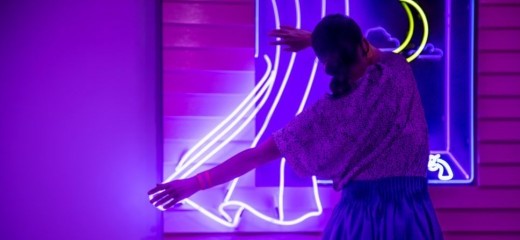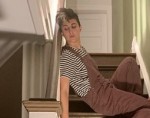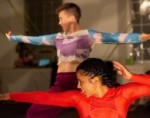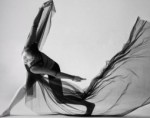
Unseen Connections at the Philadelphia Museum of Art
by Joseph Ahmed
“So many of the things we deem invisible are just unseen,” the soft voice whispers to me through my headphones as I gaze out of a window in the Philadelphia Museum of Art. I spy a group of visitors chatting, framed by the Center City skyline. “Who stood here 1,000 years ago, before there was a building?” Guided into a delicious sense of presence by this meditative opening, I’m all too ready to engage in the intricate exploration that follows, where I am as much dancer as audience.
The Garden: Invisible Branches, by Nichole Canuso Dance Company, connects through its own invisible branches to past iterations at venues like The Powerplant Basement and The Bok Building. Marked by small audiences guided by headphones, these interactive performances involved spatial and often contact-based interactions with performers.
Now commissioned to inhabit the museum’s bold New Grit: Art & Philly Now exhibit of 25 contemporary artists with a Philadelphia connection, the company has thoughtfully adapted the piece to a twenty-minute format featuring socially distant interactions with the seven-person cast. These, sometimes hilariously, occur around and between befuddled museum-goers. I note that Canuso’s work is the only movement practice on exhibit, reflecting the ongoing conversation around under-representation of dance in museum spaces.
Only four audience members can view the piece in each twenty-minute slot, each of their paths meandering through a few rooms of the exhibit, largely separate except for key intersections. I am lucky enough to take two paths during my visit, which feature some overlapping and some unique content. During my first experience, performer Rhonda Moore* guides me from the window where I began, her gait purposeful and her gaze gently turning from me to the bright geometry of Odili Donald Odita’s Walls of Change mural.
Suddenly the voice in my ear directs, “Sit down here.” An over-obedient audience member, I instantly plop into a cross legged seat on the floor, startling a visitor near me. Gracefully, Rhonda gestures towards a seat in front of me that I missed in my haste. I laugh and take it.
Soon the performer Mieke D sits across from me, bridging the gap with precise eye contact. The narration prompts me to mirror their movements and we initiate a gestural dance of touches and tangled arms. “Close your eyes. Continue the dance.” I continue to sweep the air until directed to open my eyes. I open them, and Mieke is gone. I laugh again. “Like Batman,” I remark out loud.
A trio of performers replace Mieke, swaying in and out of the galleries in front of me. Their sudden appearances and disappearances strike me as a much more legato version of the classic Scooby-Doo hallway chase. The trio is followed by a brief but moving solo in which Arielle Pina rises from a motionless pose on the floor beside a giant urn, a piece by Roberto Lugo that memorializes Michael Brown. Her motion dispels the initial image of death as she twists in graceful arcs then guides me to a final window. Outside of it, Mieke and Rhonda are joined by stage manager Mel Leeds to wrangle a massive blue cloth, wind-whipped into a river of fabric that connects their bodies.
Throughout the piece, the seven-person ensemble, which also includes Eun Jung Choi, Jose Guillermo Ortega Tanus, Simon Canuso Kiley, and Nichole Canuso herself, guides the experience with remarkable precision and grace even in the midst of a sometimes-unpredictable public setting. Rebecca Kanach’s costume design cleverly complements Odita’s mural with bold colors and eclectic patterns. I consider as co-stars the sound designers Michael Kiley and Adiah Hicks, who fold expansive sci-fi vibes with acoustic guitars and gentle sound effects beneath the precise and evocative narration. (Can I get it on my Spotify, please?)
During the pandemic it has become a common trope that we are “connected though distant” which is usually just a euphemism for “on Zoom.” The piece doubles down on this idea of invisible connection, and pulls it off through clever scientific metaphors, thematic movement, and a decolonizing impulse. Early on I’m invited to think of atoms as “fuzzy probability clouds” that never truly touch, but influence each other even when separate. This begins to feel palpable when drawn into choreography built of yearning reaches and oodles of intentional eye contact. Even the past enters the space as the narration impels me to imagine scenes of Lenapehoking before it became Philadelphia.
This theme of invisible connection sings in the exhibit setting, where choreographic images often echo the artwork on display. At one point I swear I’m dancing a trio with both Nichole and the outlined image of a body in Tiona Nekkia McClodden’s video installation in the next room. The only limitation of small audience work like this is that it feels short at twenty minutes. However, since it’s in a public exhibit there’s the cheeky option to hang around in the exhibit afterwards and pass as one of the bemused pseudo-audience members, connected to the performers in yet another not invisible, but simply unseen way.
*Rhonda Moore is a writer and board member for thINKingDANCE.
The Garden: Invisible Branches, Nichole Canuso Dance Company, Philadelphia Museum of Art, May 21 - June 19.
By Joseph Ahmed
May 27, 2021










